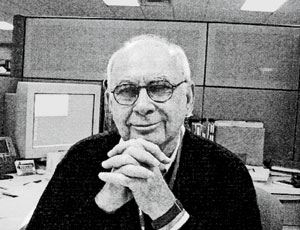 |
| Photo courtesy James Walden |
|
In the archival photo above, Walden is the teacher standing in the background. |

Starting an architecture school in a developing country was not part of my life plan when I launched my career more than half a century ago. Yet in 1960, five years after graduating from Texas A&M University with a B.Arch. and three years after joining the architecture faculty there, the U.S. Agency for International Development (USAID) invited me and two fellow architects to travel to South Asia to establish an architecture and planning school at the East Pakistan University of Engineering and Technology in Dacca (now Dhaka).
I had seen a notice that USAID was seeking candidates, and although I had already been accepted to graduate programs, I opted for the adventure of the unknown. With my wife and two children, I set off for East Pakistan (which became Bangladesh in 1971). I was joined by Dik Vrooman, a fellow professor at Texas A&M, and Dan Dunham, who was working in Dacca for Berger Engineers. Both Dik and Dan are now deceased, leaving me to write this memoir of our efforts'an enterprise that far exceeded my wildest dreams. Not only did we get the school off the ground, but it continues to thrive today.
In February, the school celebrated its 50th anniversary with a weeklong seminar on architectural education and research. Now called the Bangladesh University of Engineering and Technology (BUET), the school invited me to deliver the opening keynote address. I made the long journey from my home in Connecticut, and my arrival in Dhaka immediately kindled strong memories.
When Dik, Dan, and I landed in Dacca in early 1961, we had nothing except our enthusiasm: no classrooms, offices, curriculum, or students. The vice chancellor, an MIT graduate from Bengal, quickly found space for us in existing undistinguished buildings. We then set about devising a curriculum for a five-year undergraduate program (the program later expanded to offer master's degrees).
There was no handbook on starting an architecture school, let alone one in a far-flung locale, in a country much different from our own. We knew we needed to offer classes in basic design, as well as those in strength of materials and in math. We made humanities a requirement, too. We had brisk discussions about developing a curriculum around Islamic architecture; instead we settled on design studios that encouraged students to be inspired, broadly, by the culture of East Pakistan. (In one studio, I assigned students to design a village school made of materials transportable to the site by a simple boat.)
We also had to recruit students. An advertisement we posted drew hundreds of applicants, and we created an entrance exam to separate the wheat from the chaff. The last question asked candidates to fold a blank piece of paper into an interesting shape and leave it on their desks.
Even though it went against the norm, we decided to accept female students. In the end, our inaugural class, in the fall of 1961, comprised 26 men and three women. I have succeeded in contacting almost all of the surviving members of the first class of graduates and saw many of them at the anniversary celebration. Everyone I have spoken to either owns a firm or holds a senior-level position. They are scattered all over the globe, from Singapore to Canada.
All did not go smoothly in Dacca in the early 1960s. The school was part of a larger USAID initiative in Pakistan, a country long dependent on foreign assistance. There were monsoon rains and hurricanes that blew up from the Bay of Bengal. There were frequent student riots and general unrest. In 1965, Pakistan and India went to war.
Remarkably, this barely interrupted our coursework. We remained focused. Wonderful things happened, too. I was allowed to design faculty housing and a student center on campus. I met Louis Kahn, a frequent visitor to Dacca in those years because he was designing the National Assembly of Bangladesh. One evening, I hesitantly called him at the bungalow where he was staying and explained how badly I wanted to go to the University of Pennsylvania, where he was a professor. Kahn asked to meet and see my work, and he then promptly arranged for a fellowship that made it possible for me to attend. I earned my M. Arch. and master's in City Planning at Penn in 1968.
I stayed in Dacca for five years, leaving in 1966. Dik and Dan left a couple years later. Back in the United States, I started my own practice in Greenwich, Connecticut, which was absorbed by a New York firm 25 years later. I then worked for Helpern Architects, Lothrop Associates, and Thorton Tomasetti (where I still do some consulting work).
As was clear from my recent trip to Dhaka'my first visit since I left in '66'our little school has grown to become one of the largest and most successful architecture and planning schools on the subcontinent. It now has its own building, a distinguished faculty, and about 400 students. (USAID no longer provides funding.)
Our modest contribution clearly delivered a huge return. The school's success is a tribute to not only our efforts, but to all of the professors who followed in our footsteps. I'm now in talks with the architecture school at Texas A&M and BUET about reestablishing a student- and faculty-exchange program between the two schools. Wouldn't it be wonderful for a new era of architects to attend a 100th anniversary celebration?

Post a comment to this article
Report Abusive Comment